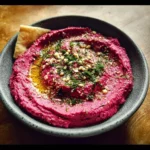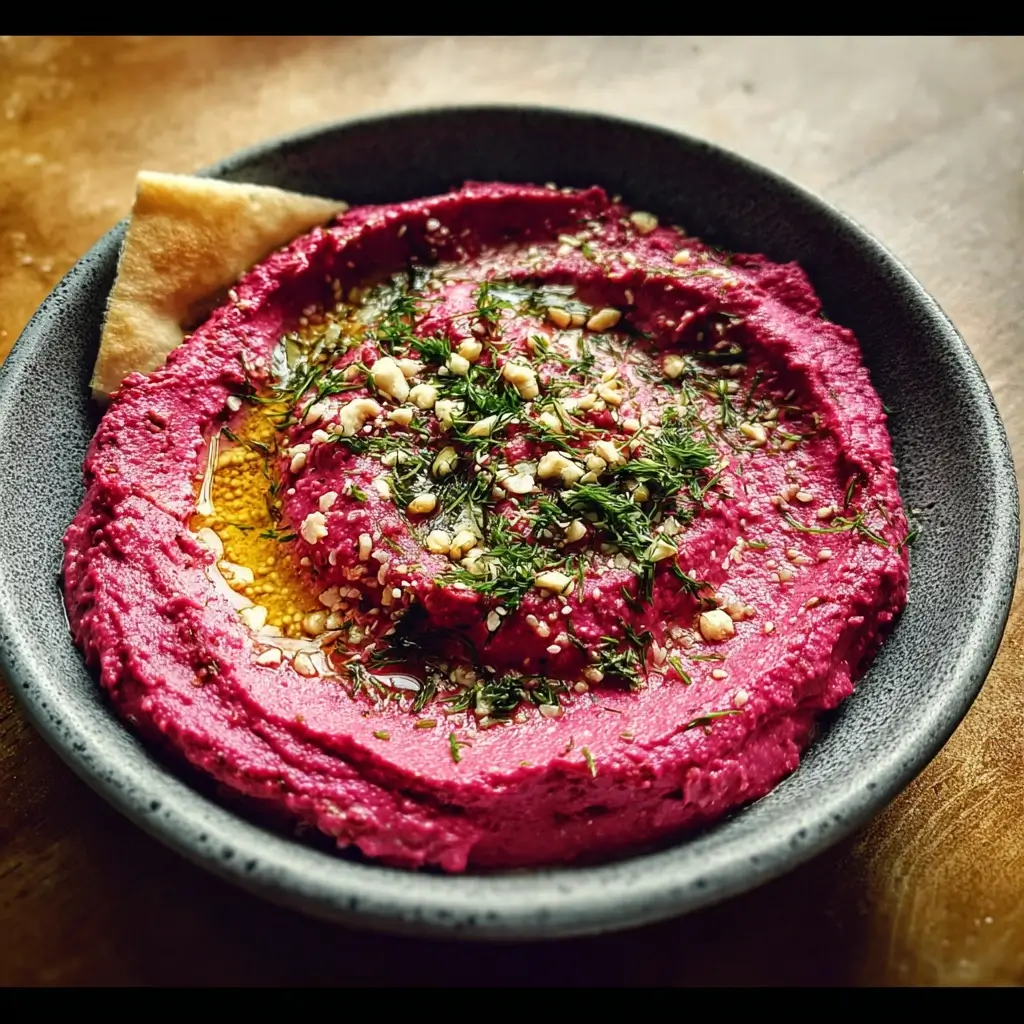The first time I placed a bowl of this vibrant, shockingly pink dip on the table during a family get-together, the conversation stopped. My nephews, who usually run screaming from anything remotely vegetable-related, were suddenly intrigued. “What is that?” they asked, pointing at the dazzling magenta swirl. I called it my “secret dragon dip,” and they were instantly hooked. They devoured it with pita chips, carrot sticks, and even just their fingers, leaving a trail of pink evidence behind. What they didn’t know was that my secret weapon was the humble, earthy beet, transformed into something magical. This Bloody Beet Hummus, named for its deep, rich, blood-red hue, has since become a legend in our household. It’s the recipe I’m asked to bring to every potluck, the healthy snack my partner requests for work, and the one dip that can make even the most skeptical eaters fall in love at first bite. It’s more than just a recipe; it’s a conversation starter, a centerpiece, and a deliciously healthy way to add a spectacular splash of color to any meal. The beauty of this hummus lies in its perfect balance—the natural sweetness of the roasted beets melds flawlessly with the creamy tahini, the bright tang of lemon, and the subtle warmth of garlic and cumin. It’s a culinary masterpiece that looks as incredible as it tastes, and I am thrilled to share the secrets behind this show-stopping dish with you.
Ingredients
- 1 pound raw beets (about 2-3 medium-sized beets): The star of the show. Roasting them brings out a deep, earthy sweetness that is essential for the flavor profile.
- 1 can (15-ounce) chickpeas (garbanzo beans): Rinsed, drained, and if you have the patience, peeled for the ultimate creamy texture.
- 1/2 cup high-quality tahini: This sesame paste is the soul of hummus, providing a rich, nutty flavor and a velvety consistency. Choose a brand that is smooth and not overly bitter.
- 1/4 cup freshly squeezed lemon juice: Essential for cutting through the richness of the tahini and the earthiness of the beets, adding a bright, zesty kick.
- 2 cloves garlic, roughly chopped: Adds a pungent, aromatic warmth. Adjust the amount based on your love for garlic.
- 2 tablespoons extra virgin olive oil: A good quality olive oil enriches the hummus, making it smoother and adding a touch of fruity, peppery flavor.
- 1 teaspoon ground cumin: This warm, earthy spice is a classic hummus ingredient that pairs beautifully with both chickpeas and beets.
- 1 teaspoon sea salt (or to taste): Crucial for enhancing all the other flavors in the dish.
- 3-5 tablespoons of ice-cold water: The secret weapon for achieving a light, whipped, and incredibly smooth texture.
Instructions
- Prepare and Roast the Beets: Preheat your oven to 400°F (200°C). Wash and scrub the beets thoroughly to remove any dirt. Trim off the leafy tops and the root ends. Wrap each beet individually in aluminum foil, place them on a small baking sheet, and roast for 50-60 minutes. The roasting time will vary depending on the size of your beets. They are ready when a fork or knife can be easily inserted into the center with little resistance.
- Cool and Peel the Beets: Once roasted, carefully remove the beets from the oven. Open the foil packets to allow the steam to escape and let them cool for about 15-20 minutes, or until they are cool enough to handle. The skins should slip off easily with your hands or by gently rubbing them with a paper towel.
- Chop the Beets: Roughly chop the peeled beets into smaller, manageable chunks. This will make it easier for your food processor or blender to break them down smoothly. Set aside.
- Combine Ingredients in Food Processor: In the bowl of a food processor or a high-powered blender, combine the tahini and the fresh lemon juice. Pulse for about 60 seconds. This step, known as “whipping the tahini,” is crucial for a creamy final product. The mixture will thicken and become paste-like. Scrape down the sides of the bowl.
- Add Core Hummus Ingredients: To the whipped tahini mixture, add the rinsed and drained chickpeas, chopped garlic, extra virgin olive oil, ground cumin, and sea salt.
- Blend Until Smooth: Process the mixture for a solid 2-3 minutes until it starts to become smooth. It will still be quite thick at this stage. Scrape down the sides and bottom of the bowl again to ensure everything is being incorporated evenly.
- Incorporate the Roasted Beets: Add the chopped, roasted beets to the food processor. Continue to blend for another 2-3 minutes. The mixture will transform into a vibrant, deep pink color.
- Achieve the Perfect Texture: With the food processor running, slowly drizzle in the ice-cold water, one tablespoon at a time. Continue to blend until the hummus reaches your desired consistency—light, airy, and exceptionally creamy. This process can take another 2-4 minutes. Don’t rush this step; the longer you blend, the smoother it will be.
- Taste and Adjust: Stop the processor and taste the hummus. This is your chance to perfect it. Does it need more salt? A little more lemon juice for tang? An extra pinch of cumin for warmth? Adjust the seasonings to your personal preference and give it one final pulse to combine.
- Serve or Store: Transfer the Bloody Beet Hummus to a serving bowl. You can serve it immediately, garnished as you wish, or store it in an airtight container in the refrigerator for up to a week. The flavor often deepens and improves after a day.
Nutrition Facts
- Servings: Makes approximately 12 servings (2 tablespoons per serving).
- Calories per serving: Approximately 85 calories.
- Fiber: Rich in dietary fiber from both the chickpeas and the beets, this hummus supports healthy digestion and promotes a feeling of fullness, making it a satisfying and healthy snack.
- Healthy Fats: The tahini and olive oil provide heart-healthy monounsaturated fats, which are essential for overall health and can help in managing cholesterol levels.
- Manganese: Beets are an excellent source of manganese, a trace mineral that plays a vital role in bone formation, metabolism, and protecting cells from oxidative damage.
- Folate (Vitamin B9): This hummus is a good source of folate, which is crucial for cell growth and function. It’s particularly important for creating red and white blood cells in the bone marrow.
- Plant-Based Protein: The combination of chickpeas and tahini delivers a solid punch of plant-based protein, which is essential for muscle repair and building a healthy body.
Preparation Time
The entire process of making this vibrant hummus takes approximately 1 hour and 20 minutes. However, this can be broken down into:
- Active Time (15-20 minutes): This includes the time you spend washing and preparing the beets, peeling them after roasting, and the actual blending process.
- Passive Time (60-70 minutes): This is the time the beets spend roasting in the oven and then cooling down before they can be handled. You can use this time to prepare other parts of your meal or simply relax!
How to Serve
This Bloody Beet Hummus is incredibly versatile. Its stunning color and delicious flavor make it a fantastic addition to almost any meal or snack time. Here are some of the best ways to serve it:
- As a Classic Dip Platter:
- Create a beautiful “mezze” platter by surrounding a bowl of the beet hummus with a variety of dippers.
- Breads: Warm pita bread, toasted sourdough slices, crispy pita chips, or seeded crackers.
- Vegetables: A rainbow of fresh, crunchy vegetables like carrot sticks, cucumber slices, bell pepper strips (yellow and orange look amazing against the pink), celery sticks, and blanched asparagus spears.
- As a Gourmet Sandwich or Wrap Spread:
- Elevate your lunch by slathering this hummus on your favorite bread or tortilla. It acts as a flavorful, moist, and healthy alternative to mayonnaise or other spreads.
- Perfect Pairings: It’s incredible in a wrap with grilled chicken or falafel, feta cheese, fresh spinach, and a sprinkle of sunflower seeds for crunch.
- Toast Topper: Spread it generously on a thick slice of toasted multigrain bread and top with avocado slices, a sprinkle of everything bagel seasoning, and a drizzle of olive oil for a fabulous breakfast or light lunch.
- As a Healthy Bowl Topper:
- Add a generous dollop to your favorite grain bowls or salads for a boost of flavor, color, and nutrients.
- Buddha Bowls: It pairs wonderfully with quinoa, roasted sweet potatoes, kale, pickled red onions, and a protein of your choice.
- Salad Dressing: Thin the hummus with a little extra lemon juice and water to create a creamy, vibrant salad dressing that will make any simple green salad pop.
- In Creative Appetizers and Canapés:
- Use the hummus as a base for elegant and easy appetizers for your next party.
- Cucumber Bites: Pipe or spoon the hummus onto thick cucumber rounds and top with a crumble of goat cheese and a fresh dill sprig.
- Deviled Eggs: Replace the traditional yolk filling with this beet hummus for a stunning and surprisingly delicious twist on a classic. Garnish with chopped chives.
- Bruschetta: Spread it on small toasted baguette slices and top with roasted walnuts and a drizzle of balsamic glaze.
Additional Tips
- Don’t Skip Roasting the Beets: While you can use boiled or even canned beets in a pinch, roasting is the superior method. It caramelizes the natural sugars in the beets, concentrating their flavor and resulting in a much sweeter, less “muddy” taste than boiling.
- The Ultimate Creamy Hummus Secret: For a truly restaurant-quality, velvety smooth texture, take the extra 10 minutes to peel your chickpeas. After rinsing, simply pinch each chickpea, and the skin will slide right off. It seems tedious, but the difference in creaminess is astounding.
- Whip the Tahini First: As mentioned in the instructions, blending the tahini and lemon juice together before adding anything else is a game-changer. This process, called aeration, makes the tahini lighter and creamier, preventing it from seizing up when other ingredients are added and ensuring a fluffy final product.
- Invest in Good Quality Tahini: The flavor of your hummus is heavily dependent on the quality of your tahini. Look for brands made from 100% sesame seeds, often from Middle Eastern markets. A good tahini should be smooth, pourable, and have a nutty, rich flavor, not a bitter or chalky one.
- Patience with the Processor: Don’t be afraid to let your food processor run for several minutes at each stage. The key to smooth hummus is time. Scrape down the sides of the bowl frequently to ensure there are no unblended chunks of chickpea or beet hiding at the bottom.
- Garnish Like a Pro: Presentation elevates the experience. Before serving, create a swirl in the hummus with the back of a spoon. Drizzle with a high-quality extra virgin olive oil and sprinkle with toppings that add flavor and texture. Toasted sesame seeds, chopped fresh parsley or cilantro, crumbled feta or goat cheese, or toasted walnuts are all fantastic options.
- Make It Ahead for Better Flavor: This hummus is a great make-ahead dish. In fact, the flavors tend to meld and deepen overnight. Store it in an airtight container in the refrigerator. It might thicken up slightly when chilled; simply give it a good stir and, if needed, add a teaspoon of water or lemon juice to loosen it before serving.
- Freezing for Future Cravings: You can absolutely freeze homemade hummus. Portion it into freezer-safe containers, leaving a little space at the top for expansion. Drizzle a thin layer of olive oil over the top to prevent it from drying out. It will keep well in the freezer for up to 3 months. Thaw it in the refrigerator overnight and give it a vigorous stir before serving.
FAQ Section
1. Why is it called “Bloody Beet Hummus”?
The name is a playful and descriptive nod to the incredibly deep, rich, red-purple color the hummus gets from the roasted beets. It resembles the color of blood oranges or, more dramatically, blood itself, making the name memorable and intriguing. It’s a great conversation starter at parties and a fun way to describe its stunning, all-natural hue.
2. Can I use pre-cooked or canned beets instead of roasting my own?
Yes, you absolutely can use pre-cooked, vacuum-sealed beets or canned beets to save time. Drain them well before using. However, be aware that the flavor profile will be different. Roasted beets offer a much deeper, sweeter, and more complex flavor. Canned or pre-cooked beets can sometimes have a more watery and less intense flavor, so you may need to adjust your seasonings accordingly.
3. My beet hummus isn’t as smooth as I want it to be. What did I do wrong?
There are a few common culprits for grainy hummus. First, you may not have blended it long enough. A truly smooth texture can take 5-7 minutes of total blending time in a good food processor. Second, peeling the chickpeas makes a significant difference. Third, make sure you add the ice-cold water slowly while the processor is running; this helps emulsify the mixture into a creamy whip. Finally, the power of your food processor or blender plays a role; a high-powered machine will yield smoother results.
4. How long can I store homemade Bloody Beet Hummus?
Stored in an airtight container in the refrigerator, this beet hummus will stay fresh and delicious for up to one week. The flavors will actually get better after the first day! If you notice any off smells or mold, it’s time to discard it.
5. Is this beet hummus recipe healthy?
Yes, it is incredibly healthy! It’s packed with nutrients. You get fiber and plant-based protein from the chickpeas, essential vitamins and minerals like folate and manganese from the beets, and healthy monounsaturated fats from the tahini and olive oil. It’s a naturally vegan, gluten-free, and dairy-free snack that is both satisfying and nourishing.
6. Can I make this recipe without tahini?
While tahini is traditional and provides the signature nutty flavor and creamy texture of hummus, you can make it without if you have a sesame allergy or don’t have any on hand. You can substitute it with a neutral-flavored nut butter like cashew butter or sunflower seed butter for a similar creamy consistency. The flavor will change, but it will still be a delicious beet dip.
7. My hummus tastes a little too “earthy.” How can I fix that?
The “earthy” flavor comes from a compound in beets called geosmin. Some people are more sensitive to it than others. To balance the earthiness, you can increase the amount of bright, acidic, and warm flavors. Try adding an extra squeeze of fresh lemon juice, a bit more salt, or even a pinch of a warming spice like smoked paprika or coriander. Roasting the beets well also helps mellow out this flavor.
8. What other flavors or spices can I add to this recipe?
This recipe is a wonderful canvas for experimentation! To add a smoky flavor, incorporate a teaspoon of smoked paprika. For a little bit of heat, add a pinch of cayenne pepper or a chopped chipotle pepper in adobo sauce. You can also blend in fresh herbs like dill, mint, or cilantro for a fresh, herbaceous twist. A swirl of balsamic glaze on top before serving also adds a lovely sweet and tangy dimension.

Bloody Beet Hummus
- Total Time: 90 minutes
Ingredients
- 1 pound raw beets (about 2–3 medium-sized beets): The star of the show. Roasting them brings out a deep, earthy sweetness that is essential for the flavor profile.
- 1 can (15-ounce) chickpeas (garbanzo beans): Rinsed, drained, and if you have the patience, peeled for the ultimate creamy texture.
- 1/2 cup high-quality tahini: This sesame paste is the soul of hummus, providing a rich, nutty flavor and a velvety consistency. Choose a brand that is smooth and not overly bitter.
- 1/4 cup freshly squeezed lemon juice: Essential for cutting through the richness of the tahini and the earthiness of the beets, adding a bright, zesty kick.
- 2 cloves garlic, roughly chopped: Adds a pungent, aromatic warmth. Adjust the amount based on your love for garlic.
- 2 tablespoons extra virgin olive oil: A good quality olive oil enriches the hummus, making it smoother and adding a touch of fruity, peppery flavor.
- 1 teaspoon ground cumin: This warm, earthy spice is a classic hummus ingredient that pairs beautifully with both chickpeas and beets.
- 1 teaspoon sea salt (or to taste): Crucial for enhancing all the other flavors in the dish.
- 3–5 tablespoons of ice-cold water: The secret weapon for achieving a light, whipped, and incredibly smooth texture.
Instructions
- Prepare and Roast the Beets: Preheat your oven to 400°F (200°C). Wash and scrub the beets thoroughly to remove any dirt. Trim off the leafy tops and the root ends. Wrap each beet individually in aluminum foil, place them on a small baking sheet, and roast for 50-60 minutes. The roasting time will vary depending on the size of your beets. They are ready when a fork or knife can be easily inserted into the center with little resistance.
- Cool and Peel the Beets: Once roasted, carefully remove the beets from the oven. Open the foil packets to allow the steam to escape and let them cool for about 15-20 minutes, or until they are cool enough to handle. The skins should slip off easily with your hands or by gently rubbing them with a paper towel.
- Chop the Beets: Roughly chop the peeled beets into smaller, manageable chunks. This will make it easier for your food processor or blender to break them down smoothly. Set aside.
- Combine Ingredients in Food Processor: In the bowl of a food processor or a high-powered blender, combine the tahini and the fresh lemon juice. Pulse for about 60 seconds. This step, known as “whipping the tahini,” is crucial for a creamy final product. The mixture will thicken and become paste-like. Scrape down the sides of the bowl.
- Add Core Hummus Ingredients: To the whipped tahini mixture, add the rinsed and drained chickpeas, chopped garlic, extra virgin olive oil, ground cumin, and sea salt.
- Blend Until Smooth: Process the mixture for a solid 2-3 minutes until it starts to become smooth. It will still be quite thick at this stage. Scrape down the sides and bottom of the bowl again to ensure everything is being incorporated evenly.
- Incorporate the Roasted Beets: Add the chopped, roasted beets to the food processor. Continue to blend for another 2-3 minutes. The mixture will transform into a vibrant, deep pink color.
- Achieve the Perfect Texture: With the food processor running, slowly drizzle in the ice-cold water, one tablespoon at a time. Continue to blend until the hummus reaches your desired consistency—light, airy, and exceptionally creamy. This process can take another 2-4 minutes. Don’t rush this step; the longer you blend, the smoother it will be.
- Taste and Adjust: Stop the processor and taste the hummus. This is your chance to perfect it. Does it need more salt? A little more lemon juice for tang? An extra pinch of cumin for warmth? Adjust the seasonings to your personal preference and give it one final pulse to combine.
- Serve or Store: Transfer the Bloody Beet Hummus to a serving bowl. You can serve it immediately, garnished as you wish, or store it in an airtight container in the refrigerator for up to a week. The flavor often deepens and improves after a day.
- Prep Time: 20 minutes
- Cook Time: 70 minutes
Nutrition
- Serving Size: one normal portion
- Calories: 85






